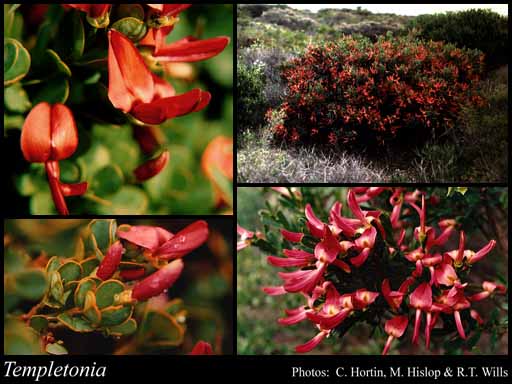- Reference
- Hort.Kew. [W. Aiton] 4:269 (1812)
- Name Status
- Current

Scientific Description
Family Papilionaceae. Bossiaeae (Templetonia group).
Habit and leaf form. Shrubs (or subshrubs form a woody stock). ‘Normal’ plants, or switch-plants; the switch forms with the principal photosynthesizing function transferred to stems. Leaves well developed, or much reduced (then reduced to minute scales and/or spiny stipules). Plants spiny (via branch tips or stipules), or unarmed. Mesophytic, or xerophytic. Leaves minute to medium-sized; alternate (‘or several at a node’); with blades, or bladeless; ‘herbaceous’, or leathery, or membranous, or modified into spines; imbricate, or not imbricate; petiolate to sessile; non-sheathing; simple, or compound; pulvinate, or epulvinate; when compound, unifoliolate, or bifoliolate, or ternate, or pinnate (then with one or two pairs of leaflets). Leaflets (0–)1–5; stipellate ((including those of 1-foliolate leaves)); pulvinate, or epulvinate; flat, or solid; without lateral lobes; sometimes terete. Leaf blades entire. Leaves with stipules (the stipules usually small and inconspicuous, rarely spiny). Stipules intrapetiolar; free of one another; scaly, or leafy, or spiny; caducous, or persistent. Leaves without a persistent basal meristem. Stem anatomy. Secondary thickening developing from a conventional cambial ring.
Reproductive type, pollination. Fertile flowers hermaphrodite. Unisexual flowers absent. Plants hermaphrodite. Pollination mechanism conspicuously specialized.
Inflorescence and flower features. Flowers solitary, or aggregated in ‘inflorescences’; when solitary, axillary; 1–5 per axil. Inflorescences simple, or compound; axillary. Flowers pedicellate; bracteate (the bracts imbricate at pedicel bases, dry and rigid or very small). Bracts persistent. Flowers bracteolate (the bracteoles ovate, papery, situated at or above the middle of the pedicels). Bracteoles persistent. Bracteoles not adnate to the receptacle. Flowers minute to medium-sized; very irregular; zygomorphic; not resupinate. The floral asymmetry involving the perianth and involving the androecium. Flowers papilionaceous (imbricate-descending, with the posterior petal outside and forming a flag (‘standard’)); basically 5 merous. Floral receptacle developing a gynophore, or with neither androphore nor gynophore. Free hypanthium present, or absent. Perianth with distinct calyx and corolla; 10; 2 -whorled; isomerous. Calyx present; 5; 1 -whorled; gamosepalous (the two posterior lobes usually joined into an upper lip, laterals rather shorter, the anterior one somewhat longer); 4–5 lobed. Calyx lobes markedly longer than the tube. Calyx imbricate, or valvate; exceeded by the corolla; bilabiate (the upper lip of two usually connate lobes, the lower three-lobed); persistent; with the median member anterior. Epicalyx absent. Corolla present; 5; 1 -whorled; appendiculate (the keel and wing petals auriculate). Standard not appendaged. Corolla partially gamopetalous. 2 of the petals joined (the two ventral petals connivent above, to form the ‘keel’ of a typical ‘papilionate’ corolla). The joined petals of the papilionate corolla anterior. The wings of the corolla free from the keel; not laterally spurred. Standard ‘normally’ developed (but not greatly exceeding the wings and keel); emarginate (sometimes reflexed); not sericeous. Keel about equalling the wings, or conspicuously exceeding the wings; not long-acuminate/beaked; neither coiled nor spiralled; not bent and beaked. Corolla imbricate (descending); glabrous abaxially; yellow, or red, or purple; persistent, or deciduous. Petals clawed. Androecial members definite in number. Androecium 10. Androecial sequence determinable, or not determinable. Androecial members free of the perianth; markedly unequal (alternately longer and shorter); coherent (into an adaxially split sheath); 1 - adelphous. The staminal tube free from the keel petals. Androecial members 1 -whorled (even though diplostemonous). Androecium exclusively of fertile stamens. Stamens 10; distinctly dissimilar in shape; diplostemonous; both opposite and alternating with the corolla members. Anthers separate from one another, or connivent; dimorphic (as regards fixing); alternately dorsifixed and basifixed (shorter and versatile, longer and basifixed); versatile; dehiscing via longitudinal slits; latrorse, or introrse; tetrasporangiate. Pollen shed as single grains. Gynoecium 1 carpelled. The pistil 1 celled. Carpels reduced in number relative to the perianth. Gynoecium monomerous; of one carpel; superior. Carpel stylate; apically stigmatic. Style (in-) curved. Style terete (subulate). Style glabrous. Stigmatic tissue terminal. Carpel (2–)5–20 ovuled (to ‘several’). Placentation marginal (along the ventral suture). Gynoecium median (the placenta posterior, on the ventral suture). Ovary sessile to stipitate. Ovules pendulous to ascending; biseriate; arillate; anatropous, or campylotropous to amphitropous, or hemianatropous.
Fruit and seed features. Fruit aerial; stipitate to sessile; non-fleshy; not hairy (glabrous). The fruiting carpel dehiscent; a legume. Pods much elongated (oblong or linear); not triangular; not becoming inflated; more or less flat, or somewhat compressed; not constricted between the seeds; not transversely septate; wingless. Valves of the dehisced pod twisted, or not twisted. Fruit 1 celled; elastically dehiscent, or passively dehiscent. Dispersal unit the seed. Fruit (1–)2–12 seeded (to ‘several’). Seeds endospermic, or non-endospermic; not mucous; somewhat compressed; small to medium sized; arillate (the aril collarlike). Cotyledons 2. Embryo straight (the radicle straight). Testa non-operculate. Micropyle zigzag, or not zigzag.
Physiology, biochemistry. Aluminium accumulation not found. Photosynthetic pathway: C3.
Geography, cytology, number of species. Native of Australia. Endemic to Australia. Australian states and territories: Western Australia, South Australia, Northern Territory, Queensland, New South Wales, Victoria, and Australian Capital Territory. Northern Botanical Province, Eremaean Botanical Province, and South-West Botanical Province. 2n = 16. A genus of about 16 species; 11 species in Western Australia.